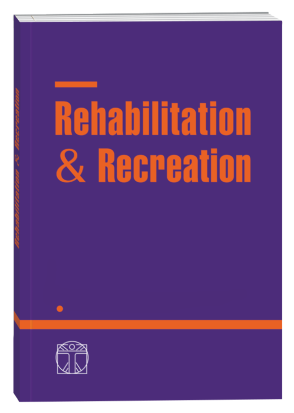EFFECTS OF SECTIONAL BREATHING TECHNIQUES ON OPTIMIZING PHYSIOLOGICAL PARAMETERS IN WOMEN ATHLETES
DOI:
https://doi.org/10.32782/2522-1795.2025.19.2.13Keywords:
Sectional breathing, Vital capacity, Heart rate, Women athletes, Respiratory trainingAbstract
Background and Study Aim. Sectional breathing techniques have been associated with enhanced respiratory function and cardiovascular efficiency. This study aimed to evaluate the effectiveness of a 12-week sectional breathing intervention on improving vital capacity and reducing resting heart rate among women athletes engaged in regular sports training. Material and Methods. A simple randomized controlled trial was conducted involving 82 women players aged 18 to 23 years, randomly assigned to either the experimental group (n = 41), which practiced sectional breathing along with regular training, or the control group (n = 41), which followed regular training without additional intervention. The intervention consisted of guided sectional breathing sessions conducted twice daily (20 minutes each) for six days a week over 12 weeks. Pre– and post-intervention measurements included vital capacity (in liters) and heart rate (in beats per minute). Repeated measures ANOVA and Bonferroni pairwise comparisons were used for statistical analysis. Results. The experimental group showed a significant increase in mean vital capacity from 3.008 L (±0.287) to 3.156 L (±0.305), supported by a large effect size (F = 448.397, p = .000, η² = .847). Similarly, heart rate significantly decreased from 55.207 bpm (±6.204) to 49.951 bpm (±5.906) (F = 246.097, p = .000, η² = .752). Pairwise comparisons confirmed statistically significant differences between pre– and post-intervention measures for both outcomes. Conclusions. The findings demonstrate that sectional breathing is an effective and time-efficient strategy to enhance lung function and improve cardiovascular efficiency in women athletes. Incorporating such respiratory training into regular sports routines may offer measurable health and performance benefits.
References
1. Bucea-Manea-Țoniș, R., Paun, D.G., Mindrescu, V., Cătună, C. (2023). Yoga, an appurtenant method to improve the sports performance of elite Romanian athletes. Sustainability, 15(5), 4264. https://doi.org/10.3390/su15054264
2. De Couck, M., Caers, R., Musch, L., Fliegauf, J., Giangreco, A., Gidron, Y. (2019). How breathing can help you make better decisions: Two studies on the effects of breathing patterns on heart rate variability and decisionmaking in business cases. International Journal of Psychophysiology, 139, 1–9. https://doi.org/10.1016/j.ijpsycho.2019.02.011
3. Du, Y., Jiang, K., Li, H. (2024). A respiratory sensor-based study of the relationship between voluntary breathing patterns and aerobic and anaerobic exercise capacity: An exploratory applied study. Sensors, 24(19), 6310. https://doi.org/10.3390/s24196310
4. Goswami, K., Sao, A.K. (2024). Effects of yoga practice on cardiovascular & respiratory parameters in professional athletes. Indian Journal of YOGA Exercise & Sport Science and Physical Education, 35–40. https://doi.org/10.58914/ijyesspe.2024-9.2.5
5. Hakked, C.S., Balakrishnan, R., Krishnamurthy, M.N. (2017). Yogic breathing practices improve lung functions of competitive young swimmers. Journal of Ayurveda and Integrative Medicine, 8(2), 99–104. https://doi.org/10.1016/j.jaim.2016.12.005
6. Harbour, E., Stöggl, T., Schwameder, H., Finkenzeller, T. (2022). Breath tools: A synthesis of evidence-based breathing strategies to enhance human running. Frontiers in Physiology, 13, 813243. https://doi.org/10.3389/fphys.2022.813243
7. Jayachitra, M. (2012). Effect of pranayama and bandha practices on selected physiological variables among adolescent girls. International Journal of Physical Education and Sports Management, 1(10), 17. https://www.researchgate.net/publication/253340909
8. Jimenez Morgan, S., Molina Mora, J.A. (2017). Effect of heart rate variability biofeedback on sport performance: A systematic review. Applied Psychophysiology and Biofeedback, 42, 235–245. https://doi.org/10.1007/s10484-017-9364-2
9. Lehrer, P., Kaur, K., Sharma, A., Shah, K., Huseby, R., Bhavsar, J., Zhang, Y. (2020). Heart rate variability biofeedback improves emotional and physical health and performance: A systematic review and meta-analysis. Applied Psychophysiology and Biofeedback, 45, 109–129. https://doi.org/10.1007/s10484-020-09466-z
10. Manna, I. (2019). Study the influence of yoga on body composition and cardio-pulmonary functions on healthy female volunteers. International Journal of Physiology, 4, 106–110. Retrieved from: https://www.journalofsports.com/pdf/2019/vol4issue2/PartC/4-1-370-758.pdf
11. Manna, I., Chowdhury, M. (2020). Effects of 12 weeks yoga practice on body composition and cardiopulmonary status of 10–12 years female volunteers. Archives of Medicine and Health Sciences, 8(2), 208–214. https://doi.org/10.4103/amhs.amhs_143_19
12. Munadi, M., Suhanda, R., Zulkarnain, Z., Azhari, M., Yulia, W. (2024). Optimization of lung vital capacity to improve athlete fitness. Journal of Social Research, 3(4), 1010–1017. https://doi.org/10.55324/josr.v3i4.1988
13. Rathod, K., Sawaliya, J.K., Panchal, D., Rathod, T., Patel, V. (2024). Effect of pranayama on competitive state anxiety among male basketball players. Yogic Approaches to Mental Health, 1(1), 27–42. https://doi.org/10.47413/vidya.v3i2.482
14. Sanjaykumar, S., Rajkumar, N.C.J., Lakshmi, P.Y. (2023). Impact of varied temperature living conditions, stress levels, and sleeping duration on oligomenorrhea: A comprehensive study among women. Physical Rehabilitation and Recreational Health Technologies, 8(4), 183–187. https://doi.org/10.15391/prrht.2023-8(4).02
15. Sanjaykumar, S., Rajkumar, N.C.J., Lakshmi, P.Y. (2024). The effects of psychological interventions on menstrual health in exercising women: A comprehensive experimental study. Physical Rehabilitation and Recreational Health Technologies, 9(2), 45–51. https://doi.org/10.15391/prrht.2024-9(2).01
16. Sanjaykumar, S., Rajkumar, N.C.J., Lakshmi, P.Y., Salini, B., Boby, F.A., Kurnaz, M. (2024). Assessing the effect of exercise timing on menstrual irregularity in women diagnosed with oligomenorrhea. Health, Sport, Rehabilitation, 10(4), 74–84. https://doi.org/10.58962/HSR.2024.10.4.74-84
17. Schober, P.D. (2018). The introduction of yoga recovery on physiological and psychological stress and performance in NCAA athletes: Master’s thesis, University of Montana. ScholarWorks. Retrieved from: https://scholarworks.umt.edu/cgi/viewcontent.cgi?article=12192&context=etd
18. Solikhin, M.N., Sumaryanti, Sulistiyono, Fauzi, Arbanto, B. (2024). Benefit of breathholding training on the concept of recreational freediving in healthy adults: A systematic literature review. Fizjoterapia Polska, 24(1), 199–204. https://doi.org/10.56984/8ZG2EF8z2j
19. Strakolyst, H.M., Bohdanovska, N.V., Bessarabova, O.V. (2023). The influence of diaphragm breathing on the state of the vessel endothelium in young women with essential hypertension. Rehabilitation and Recreation, 15, 111–117. https://doi.org/10.32782/2522-1795.2023.15.14
20. Thakare, V. (2021). Pranayama for enhancing respiratory and cardiovascular function. Ashok Yakkaldevi. ISBN: 978-1-6780-2626-4
21. Verma, A., Balekar, N., Rai, A. (2024). Navigating the physical and mental landscape of cardio, aerobic, Zumba, and yoga. Archives of Medicine and Health Sciences, 12(2), 242–250. https://doi.org/10.4103/amhs.amhs_20_24
Downloads
Published
How to Cite
Issue
Section
License

This work is licensed under a Creative Commons Attribution-NonCommercial-NoDerivatives 4.0 International License.





